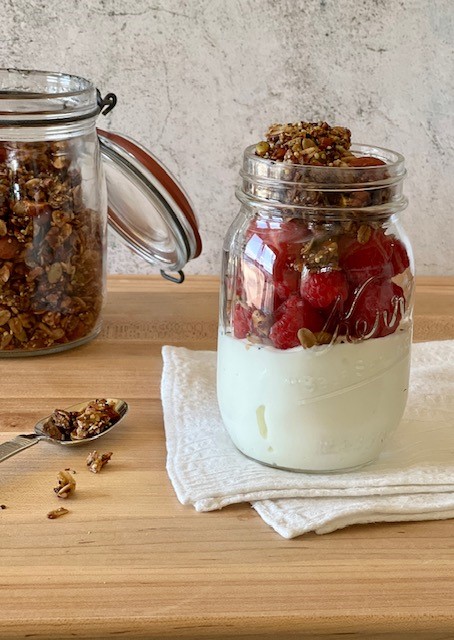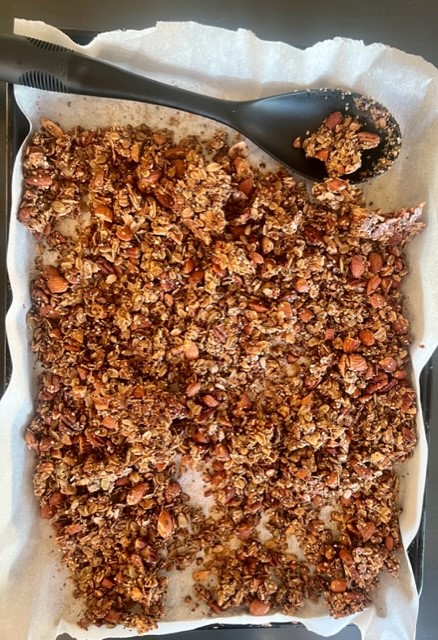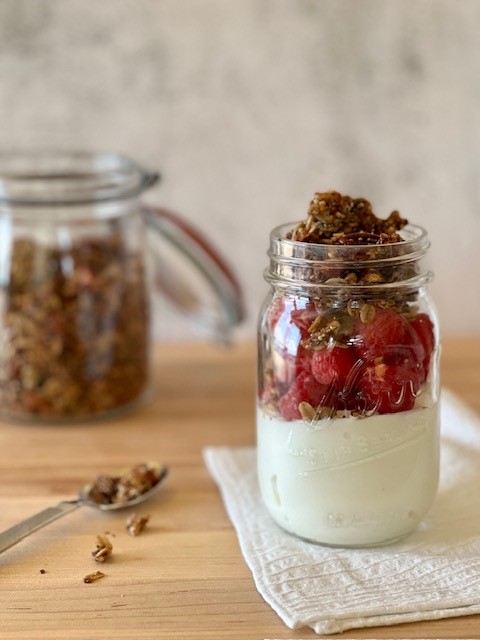Super Seedy Nutty Granola

As hard as it is to say goodbye to summer, cool fall weather green lights turning on the oven. A box of oats and a selection of nuts and seeds in my freezer was a strong suggestion to make granola. I’d forgotten just how addictive the crunchy, toasty mix can be.

It’s a cereal that has stood the test of time. The first version was called granula, derived from the Latin word for grain, granum. It was created as a health-promoting food in the 1863 by Dr. James Caleb Jackson, director of a New York sanitorium (what we’d call a health spa) with beliefs that ill-health had roots in the stomach and that his granula was a food that would somehow prepare you for the second coming, promote Christian values and reduce carnal desire (1,2,3).
A few years later, in 1867, the guy we most associate with cold breakfast cereal, John Harvey Kellogg, who also had a sanitorium, promoted what he called granola as a health food linked to his religious agenda. He went on to promote corn flakes and a host of other cereals.
Fast forward to the 1960s when granola reemerged as part of the countercultural movement. Perhaps the most iconic “hippie food,” granola was considered a natural, healthful food and alternative to processed sugary cereals.
Today, granola ingredients have evolved to include on-trend superfoods like chia, hemp and flaxseeds, olive and avocado oil, nuts like pistachios, hazelnuts and coconut, and a cornucopia of dried fruits. Keto and other grain-free versions have popped up to suit current diet trends.
I’m a fan of whole grains and wouldn’t leave out oats, a surprisingly good source of protein and the gut-friendly fibers beta-glucan and resistant starch (4). Get oat details on my Baked Carrot Cake Oatmeal blog.
Nuts and seeds are a concentrated source of nutrients – protein, dietary fiber, “healthy” fats, vitamins, minerals, antioxidant, and anti-inflammatory compounds that research shows can protect health and reduce the risk of diseases such as cardiovascular and cancer. While they seem high in calories, studies show up to 15% of the calories from nuts are not absorbed (5).
Eat a variety of nuts and seeds as they each have unique nutritional strengths. Hemp seeds are rich in protein (10 grams per 3 tablespoons) with all nine essential amino acids. They’re an excellent source of magnesium, zinc, iron, and potassium (6).
Flax seeds, which must be ground to absorb their many nutrients, are notably high in plant-based omega-3 fat alpha -linolenic acid or ALA with anti-inflammatory and other health protective properties. They’re rich in dietary fiber, both soluble and insoluble, and lignans, phytoestrogens that may protect against cancer, heart diseases and osteoporosis (7).
Read about the goodness in chia seeds and check out my Pumpkin and Chocolate Chia Puddings here.
Sunflower seeds are a budget-friendly choice, usually cheaper than other nuts and seeds. They stand out for their content of the antioxidant nutrients vitamin E and selenium (8).
Pumpkin seeds impress with their zinc, vitamin K, iron, magnesium, and potassium.
Pecans contain the carotenoids lutein, beta carotene and zeaxanthin, and the polyphenol epigallocatechin-3-gallate (EGCG) most often associated with green tea and researched for anti-cancer benefits. Plus, they’re an excellent source of vitamin E, copper and a good source of other nutrients (5,9).
Thanks to robust marketing boards, there is considerable research and information on the bounty of nutrients in walnut and almonds and their many cardiovascular and other health benefits (10,11).
Granola has always been surrounded by a “health halo” even though many commercial varieties and some recipes for homemade granola have shockingly high amounts of added sugar and calories. Those calories can be a good thing if you’re active and looking for concentrated fuel for a bike ride or hike. It makes a satisfying airplane, snack, too. Because it is so dense, the nutrition facts on the label is often based on a small, 1/4-cup serving.
Cozy up to fall baking with a batch of homemade granola – use all your favorite ingredients and tailor it to your nutrition needs.

Super Seedy Nutty Granola
Makes about 7 1/2 cups or 15 (1/2-cup) servings.
This recipe is a template for your own granola adventure. Substitute your favorite nuts and seeds for what is listed, just don’t exceed the total volume of ingredients or they won’t fit on a large baking sheet and won’t roast properly. Sub other sweet spices like cloves or allspice for part of the cinnamon. I like to add dried fruit later, sometimes to each serving, for variety. Try dried cherries, apricots, blueberries, figs or raisins.
2 cups unsalted, raw nuts such as almonds, pecans and walnuts, coarsely chopped
2 cups old fashioned oats (gluten-free if you like)
1/2 cup hemp seeds/hearts
1/4 cup raw sunflower seeds
1/4 cup raw pumpkin seeds
1/4 cup ground flax seed or flax meal
1/4 cup chia seeds
1 1/2 teaspoons ground cinnamon
1/4 teaspoon ground cardamom
3/4 teaspoon kosher salt
1/2 cup vegetable oil or extra virgin olive oil
6 tablespoons maple syrup (or 1/2 cup if you like it sweeter)
1 1/2 teaspoons vanilla extract
Optional:
Dried fruit, chopped into bite-sized pieces if large
- Adjust oven rack to middle position. Preheat oven to 325°F.
- In a large bowl, mix nuts, oats, seeds, cinnamon, cardamom and salt. Drizzle oil, maple syrup and vanilla over all and toss again.
- Spread granola on a large, rimmed baking sheet (lined with parchment for easy clean-up) and spread to an even layer.
- Roast for 15 minutes, stir well and re-spread to an even layer. Return to oven for another 10 minutes, or a little longer, until golden brown and toasty. Watch carefully so it does not over-brown.
- Remove sheet from oven and place on a rack to cool.
- Gently stir in dried fruit or add fruit to each serving later. Avoid stirring too much if you like rough clumps and chunks. The oils in nuts and seeds are perishable. Store in an airtight container in the refrigerator or freezer.
Nutrition per 1/2 cup serving: 310 calories, 7 grams protein, 5 grams dietary fiber (18% DV), 23 grams fat (2 grams saturated fat), 21 grams carbohydrate,8 grams sugar (7 grams added sugar), 65 mg sodium, 10% DV iron, 6% DV potassium, 6% DV calcium.
REFERENCES
- The Origin and History Of Granola | CulinaryLore
- Who Made That Granola? – The New York Times (nytimes.com)
- Granola – Wikipedia
- A Review of Health-Beneficial Properties of Oats – PMC (nih.gov)
- Nuts & Seeds – Today’s Dietitian Magazine (todaysdietitian.com)
- Hemp-Fortified Foods & Beverages – Today’s Dietitian Magazine (todaysdietitian.com)
- Flaxseed—a potential functional food source – PMC (nih.gov)
- Sunflower Seeds: Health Benefits, Nutrients per Serving, Preparation Information, and More (webmd.com)
- Pecans: Health Benefits, Nutrients per Serving, and More (webmd.com)
- Almond Nutrition | Health Benefits & Research (almonds.com)
- Nutrition – California Walnuts
© Lorelle Del Matto 2023
 About lorelle
About lorelle
Hi Lorelle,
Your photos are wonderful and I look forward to enjoying making some fresh granola.
Thank you !
Leo